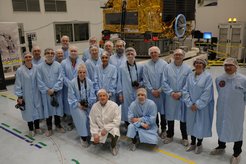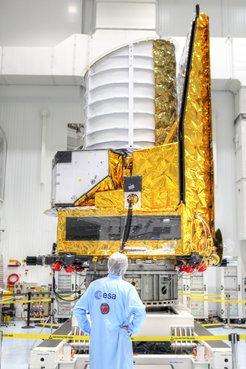Euclid team comes visiting
Shortly before being shipped to the rocket launch, the Euclid project team took a last look at the impressive satellite that will soon map the distribution of galaxies in space more precisely than ever before.

At the end of February, the Euclid project team visited the almost finalised Euclid satellite in Cannes at Thales Alenia Space. There, the 80 scientists and engineers were able to pay the spacecraft one last visit in Europe before its trip to Florida. In mid-April, the satellite will be transported by ship to the Kennedy Space Flight Center, from where it will be launched on its 1.5 million kilometre journey to the L2 Lagrange point.
Euclid will spend at least five years creating the largest and by far the most accurate three-dimensional map of the distribution of galaxies in the universe, as well as mapping their shape. This unique data set will be used to investigate two of the most burning questions in modern physics: the properties of dark matter and dark energy. These two largely unknown components of our universe – which together account for more than 95% of its energy content – have so far eluded direct observation. The team at the Max Planck Institute for Extraterrestrial Physics (MPE) has been involved in the planning and realisation of this major scientific project since the early project phases.
“After more than 14 years of work on Euclid, from the first design sketches to today, in front of the almost fully integrated spacecraft in Cannes, I am happy and deeply moved to contribute my part to this project,” says German project manager Frank Grupp from MPE in Garching. In addition to coordinating the German participation in Euclid, the team at MPE was also responsible for the optics of the Near Infrared Spectrometer and Photometer (NISP) instrument.

“With Euclid, I went through thick and thin, so to speak; especially during the first years of the project, not everyone was convinced if the near-infrared optics built at MPE could be manufactured and aligned just so,” Grupp recalls. “To date, this is the largest and most sophisticated lens system ever built for application in space – and indeed, it exceeded all expectations in the ground tests. Today, we can proudly say that our team at MPE, together with our partners in industry, has been a key contributor to Euclid.” MPE will also continue to play an essential role in the scientific evaluation as well as in the in-flight monitoring of the optics.
Euclid is expected to set off on its mission on a Space-X Falcon 9 rocket in July. “Then the excitement starts again. Once Euclid opens its eyes and sends its first images to Earth, we will see whether the whole system works as expected and if all components have survived launch and cooling down to below minus 140 degrees Celsius,” Grupp continues. “We are looking forward to fascinating new insights into the formation and evolution of the universe.”
Euclid is funded by the German Aerospace Center DLR. In addition to MPE, the Max Planck Institute for Astronomy (MPIA) in Heidelberg, as well as the Argelander Institute for Astronomy at the University of Bonn, the Ruhr University Bochum and the LMU University Observatory in Munich are German project partners in the scientific definition and exploitation of Euclid.













